
Pre-Shipment Inspection (PSI) is a quality control process conducted before goods are shipped to verify that they meet specified standards and requirements. It involves checking product specifications, quantity, packaging, labeling, and overall quality. PSI ensures that products conform to contractual agreements and international standards, reducing the risk of receiving defective or non-compliant goods. This inspection helps buyers confirm that their orders are correct and meet their expectations, thereby minimizing disputes and ensuring smooth transactions.

Pre-shipment inspection (PSI) offers several advantages. It ensures product quality by verifying compliance with specifications and standards, reducing the risk of defects. PSI helps minimize costs associated with returns and repairs and builds customer confidence by delivering high-quality products. It also enhances supply chain efficiency, reduces legal risks, and provides detailed inspection reports for informed decision-making. By fostering better supplier relationships, PSI contributes to long-term reliability and accountability.